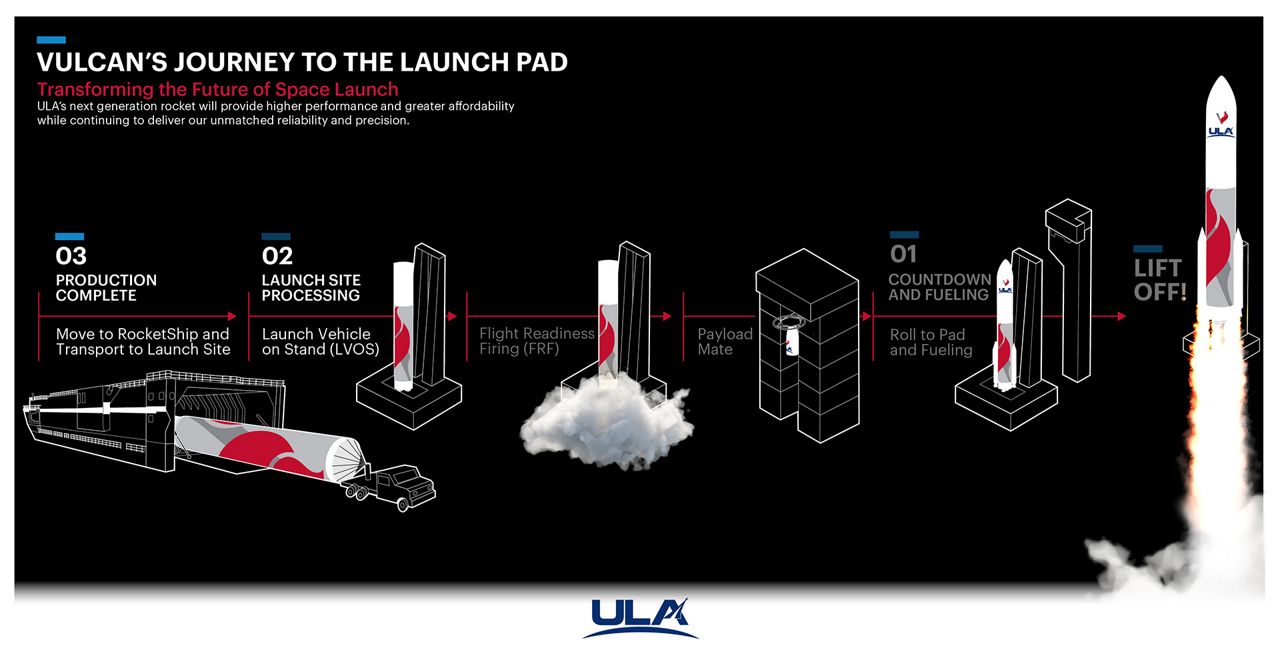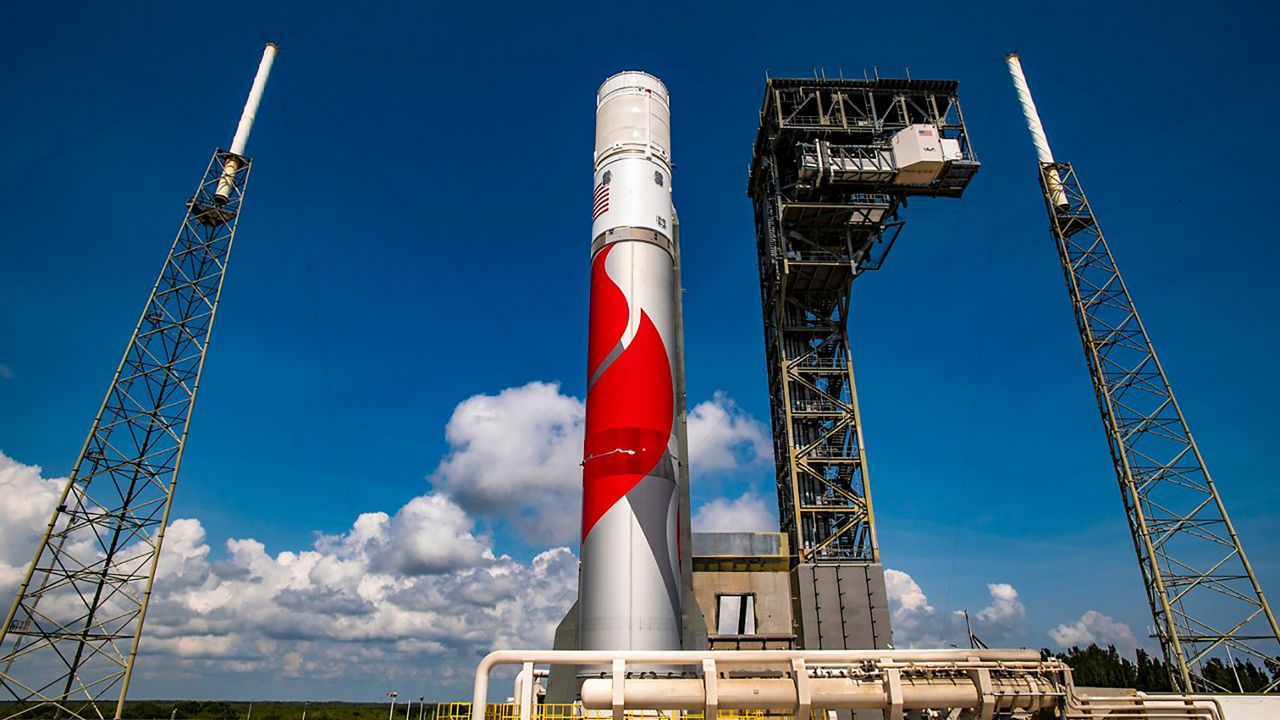CAPE CANAVERAL, Fla. — After having to pivot away from a possible Star Wars Day (May 4) launch date, United Launch Alliance’s new Vulcan rocket is working through some of the final tests that will bring it closer to its maiden launch this summer.
What You Need To Know
- ULA is set to begin a fueling test known as the wet dress rehearsal on Friday
- If tanking is successful, they will move to conduct a Flight Readiness Firing early next week
- The Cert-1 mission for Vulcan is the first of two it needs to complete before it can start flying National Security Space Launch missions for Space Systems Command and Space Force
- ULA president and CEO said if all goes well with these next tests, they expect to launch the first Vulcan rocket this summer
On Thursday, ULA teams rolled the two-stage rocket back out to the launch pad at Space Launch Complex 41 in preparation for the wet dress rehearsal on Friday, in which they will load the rocket with propellant and simulate a launch countdown, halting shortly before engine ignition.
#VulcanRocket primary subsystem testing successful. Moved into planned 30 min hold
— Tory Bruno (@torybruno) May 12, 2023
Assuming that is successful on Friday, teams will once again fuel the rocket early next week and allow a full countdown leading up to a six-second Flight Readiness Firing (FRF) test, a critical milestone before a summer flight.
“The team has performed an exhaustive review of the hardware, software, and ground systems. We have successfully completed tanking tests of the booster and the upper stage individually,” a ULA spokesperson said to Spectrum News in a statement. “The FRF will be the final functional test for the ground systems, software, first stage and engines.”
If all goes well, we'll proceed to a Flight Readiness Firing not long after that. (And yes, we plan to stream it live).
— Tory Bruno (@torybruno) May 11, 2023
In a media teleconference in February, ULA President and Chief Executive Officer Tory Bruno said the two Blue Origin BE-4 engines would fire for about 3.5 seconds at 70% thrust. He said a full-duration, first-stage flight would last about 4.5 minutes.
“But boy, 3.5 is a long time to actually beat on the pad. That is more than adequate for us to understand all those systems,” Bruno said in February.
Tweeting about the upcoming tests on Thursday, Bruno updated those metrics, stating that the burn would be “around six seconds” and “around 60 percent” thrust.
ULA further elaborated in a statement to Spectrum News, stating, “The engine will throttle up to target power for approximately 2 seconds, dwell at the target power level for 2 seconds and then power down over an approximately 2 seconds. The entire FRF will last for 6 seconds.”
ULA said it will livestream the FRF when it happens. The company will update its website with information on the livestream when it is set.
Why the delay?
Those who have been watching the development and testing campaign on the Vulcan rocket may recall that the rocket previously rolled out to the pad at SLC-41 on March 9. That was followed by a tanking demonstration test the following day.
However, later that month, there was an unplanned blast that occurred at NASA’s Marshall Space Flight Center in Huntsville, Ala., not far from ULA’s manufacturing facility in neighboring Decatur.
Bruno put out a statement on Twitter regarding the Centaur V, stating, “During Qual testing of Centaur V structural article at MSFC, the hardware experienced an anomaly.”
On April 13, he tweeted video of the burst and noted that the investigation was ongoing.
Outside of the test rig/ stand. Test article is inside (you can’t see it). Hydrogen leak. H2 accumulated inside the rig. Found an ignition source. Burned fast. Over pressure caved in our forward dome and damaged the rig. pic.twitter.com/0d0KpI1ggj
— Tory Bruno (@torybruno) April 13, 2023
Because of the ongoing investigation, ULA had to forgo the May launch window, which lasted about four days starting on May 4.
On Thursday, while responding to Vulcan questions on Twitter, Bruno said that the investigation has, “not yet concluded, but very close now. Been moving fast once we got access to the test asset,” referencing the Centaur V upper stage at Marshall.
He further elaborated in the following tweet regarding the length of the investigation:
The first few days were waiting for 19,000 lbs of liquid nitrogen to boil off from the LOX tank. Then, we needed to crane off a load head, loose platforms, the PLF simulator and the payload simulator, etc. Without damaging the evidence.
— Tory Bruno (@torybruno) May 11, 2023
When can we expect a launch?
Bruno recently said a launch of either June or July of this year is possible, with his latest statement being “summer.” He noted on Twitter that the launch crew only have about four to five days each month when the launch is viable.
That brevity is not due to constraints on the rocket, but rather the main payload: Astrobotic’s Peregrine lunar lander.
“The lunar lander has specific launch windows in order to have the conditions that are required to land on the moon,” Bruno said in February. “And it’s typically just a few days for really one launch window each month.”
Currently, the lander is sitting inside the clean room at Astrobotic’s facility in Pittsburgh. They are waiting until the Vulcan rocket is closer to being able to launch before they ship it down to Florida for processing and integration into the payload fairings.
For space fans who are able to travel to the City of Bridges, Peregrine is also visible from the adjacent Moonshot Museum, which features large windows into Astrobotic’s clean room.
Due to the failed landing of ispace’s HAKUTO-R lander and Thursday’s announcement that Intuitive Machine’s IM-1 mission to the moon is now delayed until the third quarter of 2023, Peregrine has the possibility of being the first commercial lander to successfully land on the moon.
This first mission will also carry two prototype satellites for its broadband internet constellation, Project Kuiper, as well as the memorial Enterprise Flight for Celestis.
Busy days ahead
ULA is hoping to get to the point of launch soon because some notable missions are waiting to use the pad at SLC-41 in the near future, with customers like NASA and the U.S. Space Force.
One of the most pressing is an Atlas V launch sending the Boeing Starliner CST-100 spacecraft to the International Space Station with NASA astronauts Barry “Butch” Wilmore (commander) and Sunita “Suni” Williams (pilot). As of late March, NASA and Boeing said they are still targeting no earlier than Friday, July 21, to launch the Crew Flight Test (CFT).
It’s one of 19 remaining Atlas rockets that are set to launch before that vehicle is retired and replaced by Vulcan. Another mission is the national security USSF-51, which was switched from a Vulcan to an Atlas V after Vulcan was delayed.
The U.S. Space Force’s Space and Missile Systems Center (renamed Space Systems Command in 2021) ordered USSF-51 and USSF-106 from ULA in August 2020 for $337 million.
The latter is expected to be the first National Security Space Launch (NSSL) mission to fly aboard Vulcan, which was anticipated to happen before the end of 2023.
However, before that can happen, ULA needs to fly two successful certification missions. Bruno said a May launch of the mission named Cert-1 “does not impact any of those other schedules.”
But now that Cert-1 has slipped to summer, it remains to be seen when the Cert-2 mission will take place. That second mission is expected to carry the first Dream Chaser spacecraft (named “Tenacity”) from Sierra Space to the ISS as part of the Commercial Resupply Services contract.
Sierra Space said in January that it still expects its first mission to fly “later this year.” ULA told Spectrum News that launch information, like when the Peregrine lander will be shipped to Florida and when Cert-2 could take place, will be developed in more detail “once the Centaur V test stand anomaly investigation is complete, and pending the results of the FRF.”
ULA and its customers are eager to see Vulcan begin to fly. So, the next couple weeks of testing and investigation wrap-up will be critical and key to watch.




